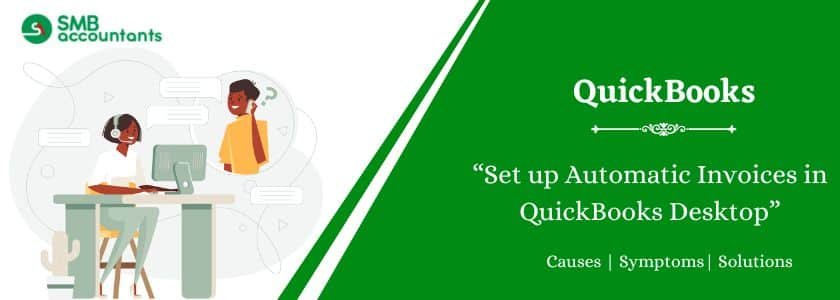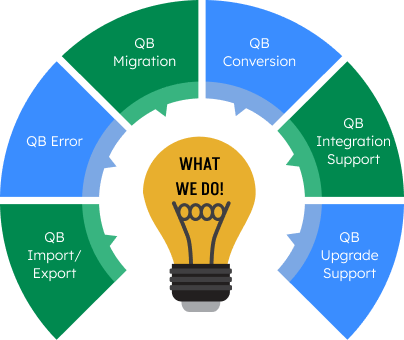QuickBooks allows you to generate automatic invoices for unpaid products or services, which is both a time saver and a convenient way to ensure that bills are issued in a timely, normal way. Here you can learn how to set up automatic invoices in QuickBooks with much ease.
Table of Contents
How to Set up Automatic Invoices in QuickBooks Desktop
With QuickBooks, you can set up automatic invoices for the services and goods that are unpaid. This ensures that your time is saved and bills are timely going out, regularly too in the most convenient manner.
Steps to Set up Automatic Invoices in QuickBooks Desktop
Scheduling of automatic invoices is done either yearly, monthly, weekly, or daily as well, you decide the same based on your needs and requirements. You can easily set the end dates and start dates for recurring payments, and the best part is that.
Follow the Steps below:
Step 1:
- Go to the drop-down menu and then click on Edit after that select Preferences
- By doing this, the Preference window will open
Step 2:
- Tap on the option of Invoice Automation by going to the Preference window’s left side
- You will see that automatic settings appear now
Step 3:
- Go to the screen automation settings and review its top portion to select the automation method
- Two options are available for invoice automation
- By tapping on the option that says, “Create invoices and tell me about it” QuickBooks will receive a prompt to get the invoice created and you will receive the notification once it is created
- If you want the hands-off approach entirely then choose “Create invoices and don’t tell me about it”.
Read this: How to Set up a Credit Card in QuickBooks
How to Create Automatic Invoices in QuickBooks Desktop
With QuickBooks, you can set up automatic invoices for unpaid services and goods. This ensures that your time is saved and bills are timely going out, regularly too in the most convenient manner.
Step 1: Set up Recurring Invoices
Autopay is accessible for recurring invoices that have payment capabilities enabled. If you haven’t configured invoices to recur yet, here’s how you can do it:
- Generate an invoice, then choose “Make recurring,” or opt to create a recurring template.
- Navigate to the Interval section and indicate the frequency of the invoice recurrence.
- Please be aware: Autopay functionality is not supported for recurring invoices set to a Daily interval or for amounts exceeding $5,000.
- Input the start and end dates for the recurring invoice.
- Complete the remaining details of the invoice, then click on “Save template.”
If you’ve already set up a recurring invoice, there’s no need to create a new one.
Note: You can edit recurring templates with Autopay setup. If you change any of these fields, Autopay will be canceled:
- Total amount
- Frequency
- Terms
- Payment options
- Email address
- Customer name
A cancellation email will be sent to your customer if Autopay is canceled.
Also, read this: How to Set up 401k in QuickBooks
Step 2: Help your customers set up Autopay
As usual, your customers receive the invoice email, but now they have the option to set up Autopay. Autopay can only be set up for the full amount. If your customer edits the amount, the Autopay option is no longer available.
To utilize autopay, your customer must have an Intuit account. If they don’t have one already, they’ll need to create a new login.
- Your customer accesses your invoice and chooses “Set up autopay” to enroll.
- Next, they sign in using their Intuit user ID, which is also used for TurboTax and Mint.
- Your customer ensures that the autopay checkbox is selected and displays the accurate frequency and start date.
- Once everything is confirmed, they click the “Autopay” button to pay the current invoice.
- A confirmation email will be sent to verify that Autopay has been successfully set up.
Step 3: Check the Autopay status of your customer
Autopay can be checked in the Activity Tracker for an invoice.
- Navigate to Sales and then select Invoices (Take me there).
- Locate the invoice you want to check for payment status.
- Click on the Status of that invoice to open the activity tracker panel.
Need Professional Help?
In case of any problem or confusion, you are free to get in touch with the SMB QuickBooks customer support team. Experts at SMB QuickBooks tech support helpdesk will listen to your issues carefully and then serve you accordingly. Call on smbaccountants.com.
Frequently Asked Questions
Q 1: Can we schedule automatic invoices for later in QuickBooks Desktop
Ans: Yes, QuickBooks allows you to schedule daily, month-to-month, or maybe yearly depending on your needs and requirements.
Q 2: How do I create a recurring invoice in QuickBooks Desktop?
Ans: Go to the Gear icon >> Recurring Transaction >> New. Select Invoice for transaction type and then hit “Ok”. Choose Scheduled for Type. Choose to automatically send emails. Complete the rest of the form and then hit the Save template. Repeat the same process for each customer you would like to create a recurring invoice.
Q 3: What are the options that come with recurring transactions?
Ans: For almost anything, you can set up recurring transactions. Recurring sales receipts, invoices, and deferred charges may be made. And, if it comes to ongoing purchases, you have some choices:
- Scheduled: Scheduled is where it takes place to automate. On any kind of calendar, you can choose to build your transactions: weekly, monthly, quarterly, annual, etc. There are a lot of choices.
- Unscheduled: This also creates a transaction that you can use over and over again, but unless you go into the recurring transaction field and use the transaction, QuickBooks Online doesn’t make the transaction.
- Reminder: This is only one step above an unplanned transaction. Here, when you log into QuickBooks Online, you will get a reminder. It is going to be on top of the dashboard. QuickBooks Online can provide you with a link to a list of ready-to-create transactions.



